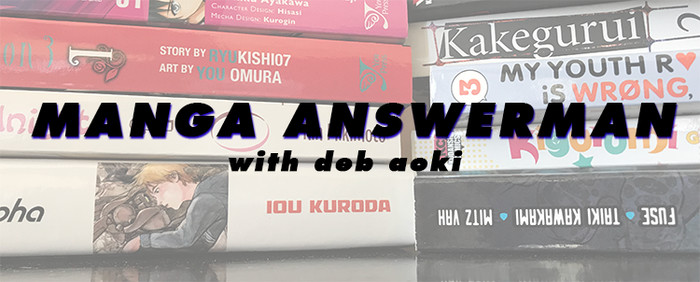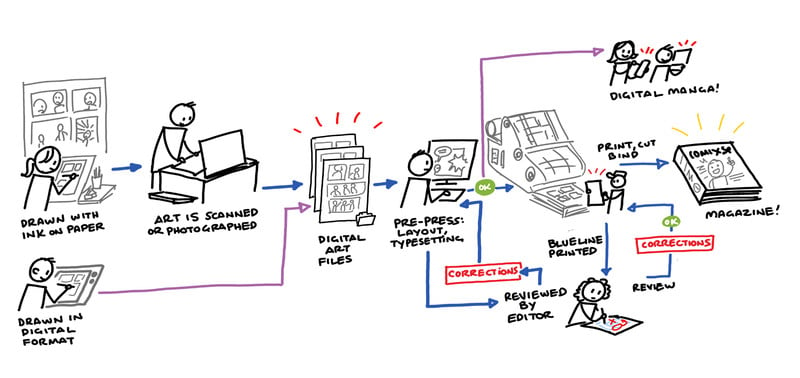Manga Answerman
What Kind Of Raw Files Do Manga Publishers Work From?
by Deb Aoki,

Q: Hi there, after a while since the last time i bought some good old paper manga, and I noticed some very good editing, maybe even TOO good, so a question came up in my mind: when a manga gets officially licensed does the publishers get a clean version of the raw without the need of much editing, or do they get the classic raw that you get from Japanese magazines?
I'm not quite sure what you mean by editing that's “TOO good” here, but I'm going to try to answer your question as best I can. (I'm going to geek out a bit about printing, so pardon some of the terminology here)
So by “classic raw” – I'm assuming you're referring to what you see distributed online by (ahem) parties who are not the original publisher or creator of the material. “Raw” in this case usually refers to scans or photos of printed manga pages from the weekly or monthly magazines before they get “cleaned up” by fan translators/localizers.
Now, at best, these “raw” pages are 3rd generation reproductions of the original manga art, and as such, they're generally lower quality reproductions. To explain what I mean by that, it's helpful to look at the process where a manga page goes from what's drawn by the artist, to what's printed in magazines, to what's seen online, and what you get when you purchase the digital or print edition of manga.
So when I say “first generation” image, I'm referring to the original art, whether it's created with pen and ink on paper or by digital drawing/image creation. This will be the art at its best, or as the artist intended. This pen on paper art is then either scanned in or photographed to get it into high-resolution digital files. The higher the resolution of the file, the more fine detail, crisp lines and screentones you'll see in the final printed reproduction.
To print artwork on paper, you need a much higher resolution image file than what you see on a computer screen on a website – for a webpage, 72 dpi (dots per inch) – 150 dpi is acceptable. For print, you need images that are at least 300 dpi – that's 2-3 times higher resolution of a web-only image file, and it results in a much bigger file, bytes-wise
These digital images are then put through the pre-press process, which includes laying out pages, adding typesetting or inserting text for the dialogue, captions, and sometimes sound effects. Also, for magazines, additional ads and side bar content is added.
The digital files of the prepared page layouts are used to create offset printing plates (here's a quick video explanation of what offset printing is - https://www.youtube.com/watch?v=5LMU-zB8Sro). Most manga magazines and manga in graphic novel format are printed this way, mostly because it's a cost-effective way to print a lot of books, magazines or newspapers.
In most cases, editors will get a “blueline” or test print of the layouts that they can mark up and request changes or adjustments. Once they get a version that looks good, they give the OK to print the books or magazines.
How a manga is printed matters, but so does paper quality. Paper that is smoother will be able to print finer lines, and depict darker tones and color gradients more evenly and accurately. Most weekly / monthly manga magazines are printed on a lower-quality, thinner or coarser paper than what's used to print the collected graphic novel editions. As a result, the image quality you see in the printed manga magazines is not as clean or crisp as the version of the same art you see in the printed graphic novel editions.
Why do Japanese publishers use this rougher paper? Mostly because it's cheaper, and costs matter when publishers want to keep the price of manga magazines affordable. Compare the paper quality and image quality of printed manga magazines from Japan vs. your average full-color comic book published by North American publishers like Marvel or DC, and also compare the price. In your average Japanese manga magazine, you'll get maybe 500-600 pages of content (with some color pages, but mostly in black and white) for about 400-500 yen or so (about $4-$5 USD). Most monthly or weekly comics magazines in N. America are roughly 28-30 pages and cost about $4-5 per issue, mostly because printing in full color is more expensive, and they're also using a higher quality, coated paper compared to the “just-a-bit-better-than-newspaper” paper used in most manga magazines.
So those “raws” you mentioned earlier are usually photos or scans from the printed pages of manga magazines. Because the manga pages are printed on cheaper, thinner and rougher textured paper, the artwork will generally look a bit fuzzy around the edges, the screentones may be muddy or have moire patterns, and the linework may be less crisp or very fine lines may be lost in the printing process. For the purposes of this discussion, I'll call these printed magazine pages “2nd generation reproductions” of the original art, digital publications of manga “1-1/2 generation reproductions” and the photos or scans of the printed magazine pages “3rd generation reproductions.
With each “generation” away from the original content, the image quality gets degraded. Many scanlation sites use these 3rd generation scans of the printed manga from magazines as the basis for the versions of the manga stories that they distribute. Because these magazine pages are printed on rougher, lower quality paper, you'll see things like ghost images from the other side of the page, or smudges on the “raw” images that need to be “cleaned up” in digital image editing programs like Photoshop.
Meanwhile, the manga pages that overseas manga publishers get from the original Japanese publishers are basically the same 1-1/2 generation digital scans / files that were used to print the comics in the Japanese editions. Therefore, they are “cleaner” than the “raw” 3rd generation photos shot from the printed magazine by uhmmm… people who aren't the original creators or authorized publishers of the material.
Anyway, that's a round-about way of explaining why the “raw” and “cleaned up” images you see online on some sites are generally not as clear or crisp as the digital or print versions you'll usually see in the official, licensed versions of the same comics content.
As a side note, this is also a less-often cited but important reason why Japanese comics creators are unhappy with unauthorized scans: it often presents their work as lower quality or significantly altered images from how they originally intended it to be presented to readers.
Do YOU have a question for the Answerman?
We want your questions! Send in as many or as often as you like. We can only pick three questions a week (and unfortunately I don't have ALL the answers) so if you haven't been chosen, don't be discouraged, and keep on sending.
However, READ THIS FIRST:
- CHECK THE ARCHIVES FIRST. I've answered a lot of questions already!
- If you want to be a voice actor, READ THIS.
- I can't tell you if or when a show will get another season. New productions are closely guarded secrets until they're publicly announced, so there's nothing I can tell you that Google can't.
- I cannot help you get in touch with any producers, artists, creators, actors or licensors. If you're trying to pitch an idea, you should read this.
- I usually won't bother with questions asking if something is a trend. Maybe? It's impossible to know until it becomes obvious.
- I take questions by email only. (Tweeted questions get ignored!)
- I will not do your homework/research/report for you.
- Keep it short -- like, a paragraph at most, and use proper grammar or punctuation.
Got all that? Great! The e-mail address is [email protected] (answerman at animenewsnetwork.com). And thanks!!
Deb Aoki was the founding editor for About.com Manga, and now writes about manga for Anime News Network and Publishers Weekly. She is also a comics creator/illustrator, and has been a life-long reader of manga (even before it was readily available in English). You can follow her on Twitter at @debaoki.
discuss this in the forum (15 posts) |
